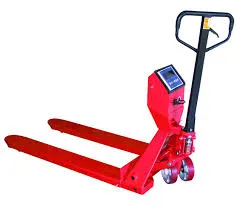


Understanding Pallet Jacks A Comprehensive Guide
A pallet jack, also known as a pallet truck, is a fundamental piece of equipment used in warehouses, distribution centers, and retail environments to move pallets efficiently. This hydraulic device simplifies the handling of heavy loads, making it an indispensable tool in the logistics and material handling industry.
What is a Pallet Jack?
At its core, a pallet jack consists of a set of forks that slide beneath a pallet, a hydraulic pump to lift the load, and wheels for maneuverability. The design is straightforward yet highly effective, allowing operators to lift and transport pallets with ease. Most pallet jacks can lift loads ranging from 2,000 to 5,500 pounds, depending on the model.
Types of Pallet Jacks
Pallet jacks come in various types, each tailored to specific tasks and environments
1. Manual Pallet Jacks The most common type, these operate through a manual hydraulic pump controlled by a handle. Operators pump the handle up and down to lift a pallet off the ground. Manual pallet jacks are cost-effective and require no electricity, making them suitable for smaller operations.
2. Electric Pallet Jacks These battery-operated models boost efficiency and ease of use, particularly in large warehouses. Electric pallet jacks can lift heavier loads with minimal physical effort, making them ideal for environments where heavy lifting is routine.
3. Heavy-Duty Pallet Jacks Designed for extreme loads, these heavy-duty versions can handle very large or particularly heavy items, providing added stability and strength.

4. Pallet Jacks with Scales These innovative models incorporate weighing systems, allowing operators to weigh pallets as they transport them. This feature can save time and improve inventory management.
Benefits of Using a Pallet Jack
The use of pallet jacks offers a myriad of benefits. First and foremost, they enhance safety in the workplace. By allowing materials to be moved without manual lifting, the risk of injuries due to strain or accidents is significantly reduced. Pallet jacks also increase efficiency; they enable quicker transportation of goods, thereby streamlining operations and improving productivity.
Moreover, pallet jacks are easy to use and require minimal training. Most employees can learn to operate them quickly, which reduces downtime associated with onboarding new personnel. Their compact design also allows them to navigate narrow aisles and tight spaces, making them ideal for various storage setups.
Maintenance of Pallet Jacks
Like any equipment, pallet jacks require regular maintenance to operate effectively. Simple tasks such as checking the hydraulic fluid level, inspecting the wheels for wear, and ensuring the forks are not damaged can significantly prolong the life of the device. Keeping the pallet jack clean and free from debris will also contribute to its longevity and performance.
Conclusion
In conclusion, pallet jacks are a vital tool in material handling, providing safety, efficiency, and ease of use. Whether leveraging a manual or electric model, businesses can enhance their operational capabilities and ensure that goods are moved smoothly throughout their facilities. As industries continue to evolve and grow, the importance of such practical equipment cannot be overstated. Investing in the right pallet jack can lead to improved productivity and a safer work environment, making it an essential consideration for any organization involved in logistics and warehousing.



